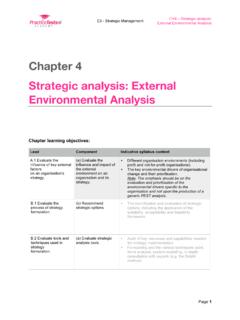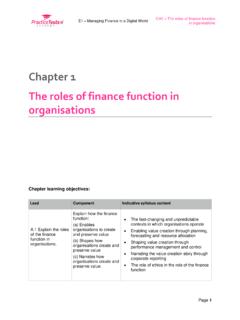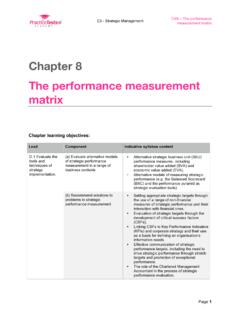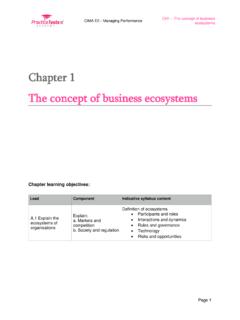Transcription of Chapter 2 Strategic analysis: Mission, vision and …
1 E3 - Strategic Management CH2 Strategic analysis : mission , vision and stakeholders Page 1 Chapter 2 Strategic analysis : mission , vision and stakeholders Chapter learning objectives: Lead Component Indicative syllabus content Evaluate the influence of key external factors on an organisation s strategy. (b) Recommend approaches to business/government relations and to relations with society. Non-market strategy and forms of corporate political activity. (c) Discuss the drivers of external demands for environmental sustainability and corporate social responsibility and the organisation s response.
2 External demands for sustainability and responsible business practices and ways to respond to these. Evaluate the process of strategy formulation. (a) Evaluate the processes of Strategic analysis and Strategic options generation. vision and mission statements and their use in orientating the organisation s strategy. The process of strategy formulation. Strategic options generation ( using Ansoff s product/market matrix and Porter s generic strategies). Scenario planning and long-range planning as tools in Strategic decision making. Value drivers (including intangibles) of business and the data needed to describe and measure them.
3 Game theory approaches to Strategic planning and decision making. Note: complex numerical questions will not be set. Real Options as a tool for Strategic analysis . Note: complex numerical questions will not be set. Acquisition, divestment, rationalisation and relocation strategies in the context of Strategic planning. E3 - Strategic Management CH2 Strategic analysis : mission , vision and stakeholders Page 2 1. mission The fundamental objective(s) of an entity expressed in general terms. - CIMA Official Terminology The mission says why you do what you do, not the means by which you do it. - Peter Drucker The mission is the basic purpose of the organisation.
4 It tries to identify its reason for existence. The strategy of the organisation should be designed to support the accomplishment of this mission . mission statement The mission statement is a published statement, apparently of the entity s fundamental objective(s). This may or may not summarise the true mission of the entity. - CIMA Official Terminology Outlines the organisation s mission . Summarises the reasoning and values that underpin its operations. Should be in writing. There is no correct format. Varies in style and length for every organisation. Is typically a short and punchy explanation of the reason for the existence of the organisation.
5 Characteristics of a mission statement: A mission statement has some or all of the following characteristics: Typically a brief statement of no more than a page in length. A general statement of the organisational culture. States the aims of the organisation. Indicates the business areas where the organisation wants to operate. Open-ended. Does not include commercial terms. Not time-assigned. Forms a basis for communication internal and external to the organisation. E3 - Strategic Management CH2 Strategic analysis : mission , vision and stakeholders Page 3 Used to formulate goals.
6 Guides the direction of the entity s strategy and, as such, is a component of management information. Examples: Google s mission is to organise the world s information and make it universally accessible and useful. Transportation as reliable as running water, everywhere for everyone. To deliver superior sustainable value, we run our business with integrity and openness, delivering optimum financial results within clearly defined business principles. Criticisms of mission statements: May not represent the actual values of the organisation Often vague Often ignored May become quickly outdated The process of creating a mission statement mission statements are normally drafted by the senior managers or directors of the organisation.
7 They are uniquely positioned to understand the high-level needs and aims of the business. A mission statement fulfils 3 purposes Communicates to all of the stakeholder groups Helps develop a corporate culture Assists in Strategic planning E3 - Strategic Management CH2 Strategic analysis : mission , vision and stakeholders Page 4 Process Step 1: The stakeholders of the organisation are customers, shareholders and employees, amongst others. Step 2: The directors can attempt to create a mission statement that reflects these aims and shows how the organisation wants to relate to the stakeholders.
8 Step 3: Any feedback on the draft can be built into the final mission statement, which can then be widely published to as many interested parties as possible. The lifespan of a mission statement There are no set rules on how long a mission statement will be appropriate for an organisation. It should be reviewed periodically to ensure that it still reflects the company s environment. If the market or key stakeholders have changed since the mission statement was written, then it may no longer be appropriate. Step 1 Analyse the stakeholders of the organisation Step 2 Identify the needs and aims of these stakeholders Step 3 A draft mission statement can then be written and distrbuted to stakeholders for review E3 - Strategic Management CH2 Strategic analysis : mission , vision and stakeholders Page 5 2.
9 vision statement The vision statement identifies the ideal position that the company wants to reach in the medium to long term. It essentially describes the longer-term aspirations of the organisation. vision statements help give a longer-term direction to the organisation s strategies. vision statements are designed to help staff make decisions and behave in such a way as to help move the company towards its ideal long-term position. Examples: To make people happy. We strive to create local opportunity, growth, and impact in every country around the world. 3. Objectives A mission is an open-ended statement of the firm s purpose and strategy.
10 Objectives are more specific and seek to translate the mission into a series of milestones for the organisation to follow. To be useful for motivation, evaluation and control purposes, objectives should be SMART S Specific M Measurable A Attainable R Relevant T Timed E3 - Strategic Management CH2 Strategic analysis : mission , vision and stakeholders Page 6 Key issues Objectives drive action. It can be difficult to prioritise multiple often conflicting objectives. This is made more complex when some objectives are hard to quantify. There will be a mix of financial and non-financial objectives.




